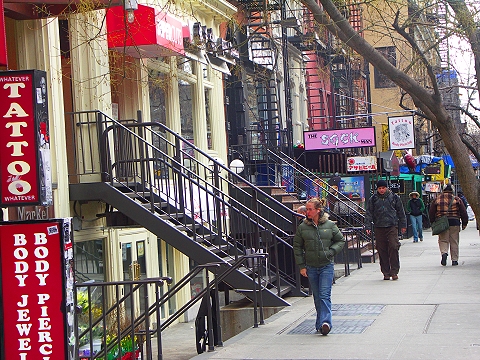BY LESLEY SUSSMAN | Alarmed at the steady loss of the retail diversity and vitality native to the East Village and Lower East Side, Community Board 3 is resolving to take proactive measures to reverse the troubling trend. The board’s basic goal is to preserve and promote individually owned mom-and-pop stores and limit the number of bars, nightclubs, banks and large retail chain stores in the area.
Taking the first step in this process, on Tuesday evening Feb. 7, members of C.B. 3’s Economic Development Subcommittee sat down to draft a mission statement on how best to bring about this vision of retail diversity for the neighborhood.
Subcommittee members explored ideas, including the establishment of “Special Purpose Districts” that would impose a set of requirements on bars, nightclubs and certain other businesses that wanted to operate in such districts. Also, they considered a “Formula Retail Tax,” in which any large retail chain wanting to open for business in the community would be charged a special fee that would be funneled back into local small shops to help them survive.
Another idea that emerged at the inaugural meeting was to give tax rebates to owners of condominium buildings who were willing to “condo out” ground floor space to small retailers. These retailers would then own their space rather than having to pay the high rents the East Village and Lower East Side are notorious for.
This option, however, came under some criticism by subcommittee member Meghan Joyce, who said the cost of purchasing a retail space would be unaffordable for some small business owners.
Subcommittee chairperson David Conn said rent remains the main issue.
“Escalating rents was the core problem in the neighborhood,” Conn said. “Ma-and-pop stores can’t afford it. Chain stores, bars and nightclubs are creating these rent escalations and driving out these small shops that provide daytime services to residents.”
A Special Purpose District, if established, would regulate the size and hours of any new bar or restaurant wanting to do business in the area.
Joyce, a bar owner herself, said she was generally supportive of the restrictive measures, but not completely.
“I’m O.K. with the regulations and want to stop new bars and restaurants from coming in,” she said. “But I also want to be able to renegotiate my lease or sell my business and have it remain open until 4 a.m. or whatever.”
Subcommittee members heard Mary DeStefano, the community board’s “urban planning fellow,” who has been working with C.B. 3 through a joint program operated by the Borough President’s Office and the Fund for the City of New York.
DeStefano presented her research on how a Special Purpose District could operate in the East Village and Lower East Side. She gave examples from similar programs that are now in operation in cities like San Francisco, Chicago and Minneapolis.
She said the establishment of any such district would require final approval by various city agencies, including the City Planning Commission, as well as the City Council.
DeStefano also discussed how a Formula Retail Tax might operate and said that such a tax would be based on the number of employees and the gross income of any large retail chain or box store that wished to do business locally.
She also reported on a retail diversity plan that was proposed by the city this year for the Upper West Side. The proposed new rezoning measure came in response to years of Community Board 7 trying to promote and preserve that neighborhood’s small shops.
DeStefano said the city’s proposal for the Upper West Side would restrict the size of individual storefronts along certain sections of Broadway and Amsterdam and Columbus Aves.
“What your committee needs to do first is design a target area and establish what special regulations you want for various businesses to open on side streets and major areas,” the urban planning fellow said.
Conn agreed with her, telling the subcommittee members that the first priority was “the need to figure out the boundaries and the formula.” He also requested more information on all the various options that were presented at the meeting.
The subcommittee also heard from C.B. 3 District Manager Susan Stetzer, who said she would like to make the subject of retail diversity in the East Village and Lower East Side, as well as other neighborhoods, an issue in the upcoming mayoral race
“It wouldn’t be a bad idea to get other community boards and groups to make sure this is brought up and becomes part of a debate for the next campaign for mayor,” she said.
She was supported by Bob Zuckerman, a C.B. 3 public member and executive director of the Lower East Side Business Improvement District. Zuckerman said the retail preservation idea was a good one because “people feel they are losing their neighborhood.”
Zuckerman, who introduced the idea of condo building owners selling store space to small shop operators, said he would do more research on this option and report back at the next subcommittee meeting.


















